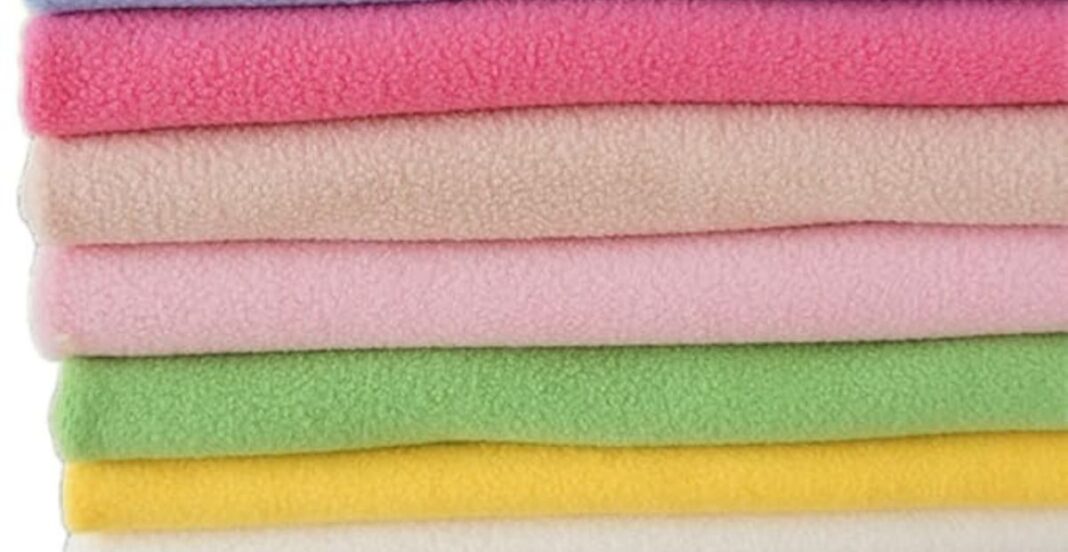Introduction
What is poly fleece and why is it a popular fabric? It insulates similarly to wool, polyester is more lightweight, and polyester fabrics dry at a faster rate than wool. Poly fleece has been a popular fabric since the late 20th century, serving as a critical component in winter clothing due to its inexpensive, warm, and easy to care for attributes.
This versatile fabric is widely used in clothing like jackets, hoodies, vests, and athletic wear. Additionally, it’s common in household items such as blankets, throws, and even pet accessories. Outdoor enthusiasts also rely on poly fleece in camping gear, scarves, and gloves.
Hoodies, jackets, athletic wear, and vests are some of the clothing items made out of poly fleece. It is also used to manufacture household items, including, but not limited to, throws, blankets and pet products. In addition to these uses, poly fleece is also used in gloves and scarves as well as camping equipment, serving the needs of outdoor enthusiasts.
How Is Poly Fleece Fabric Made?
From Polyester to Fleece
Poly fleece is manufactured using polyethylene terephthalate (PET), the same material used in plastic bottles. These bottles can be melted down and spun into fibers, making the fabric partially eco-friendly when recycled sources are used. The fibers are knitted into fabric and then brushed to enhance softness.
The Brushing Technique
Poly fleece signature fuzzy feel comes from the brushing process, which lifts its fibers. Additionally, brushed poly fleece has the added benefit of trapping warm air, providing good insulation.
Poly Fleece vs. Natural Fleece
Compared to wool fleece, poly fleece is lighter, dries faster, and is less expensive. However, wool offers better breathability and natural insulation. Poly fleece excels in moisture resistance, which makes it ideal for sportswear and wet conditions.
Types of Poly Fleece Fabric
Polar Fleece vs Microfleece vs Heavyweight Fleece
- Polar fleece is the most common type and provides the best warmth to breathability ratio of all fleece fabrics.
- Microfleece is thinner and more flexible limb garments, often worn as a base layer by children.
- Heavyweight fleece is best for outerwear as it is the thickest, and provides the most warmth.
Each kind has its own function in terms of warmth requirements and specific need.
Anti-Pill vs. Non-Anti-Pill Fleece
Fleece tends to develop small fiber clumps known as pills. Anti-pills fleece undergoes additional treatment to minimize this phenomenon. Non-anti pill fleece, although cheaper, may undergo a wear-and-tear process more rapidly.
Blended Fleece Fabrics
These are ideal for lounge and fitted jackets and even for athletic garments, as they need comfort and ease of movement.
Key Properties & Benefits of Poly Fleece

Exceptional Warmth-to-Weight Ratio
A clear advantage of poly fleece is its lightness and the warmth offered. It is a great option for layering while battling the cold as it traps heat effectively.
Moisture Wicking Abilities
Poly fleece has the advantage of wicking moisture away unlike cotton that retains it. This makes it a darling to wearers especially athletes and hikers.
Breathability and Comfort
Although not as breathable as some natural fabrics, poly fleece has moderate breathability. Lighter options like microfleece tend to be more breathable than the heavier options.
Durability and Resistance to Pilling
Its fabrics do not easily break apart, making it a dependable fleece for daily use over a considerable amount of time.
Lightweight and Quick-Drying
Poly fleece’s notability for ease of drying, as well as its lightweight nature, make it perfect for use in sports, travel, and the outdoors. Its water absorption is minimal, lined drying is easily achievable.
Common Uses of Poly Fleece

Winter Apparel
Jackets, hoodies, vests, and thermal pants made from poly fleece provide warmth without feeling too heavy. Many brands use fleece as a middle layer in technical winter clothing.
Blankets and Throws
Due to its cozy texture, fleece is a top pick for blankets, especially in colder climates. It’s lightweight yet extremely insulating.
Pet Bedding and Accessories
Pets also benefit from this soft material. It’s often used for pet beds, jackets, and travel blankets, offering comfort and warmth.
Pros and Cons of Poly Fleece
Pros
- Fleece is inexpensive when comparing to wool and other natural fabrics.
- Fleece is warm, soft, and provides insulation, making it ideal during winter.
- It is easy to clean, quick dry, and moisture resistant.
- great for activewear.
Cons
- Poly fleece is known for shedding microplastics which raises concerns for the environment.
- Provides little to no breathability in comparison to cotton or wool.
- In dry climates, poly fleece has the tendency to shock people with static electricity.
Poly Fleece vs. Other Fabrics
Cotton Fleece vs Poly Fleece
Cotton fleece is more breathable, while poly fleece is warmer, lighter, and moisture resistant. Furthermore, poly fleece is more durable due to being synthetic in nature.
Wool vs Poly Fleece
Wool is excellent for insulation and more natural, but takes longer to dry and is bulkier. Poly fleece linens dry faster and is easier to care for, making them more practical.
Is Poly Fleece Fabric Eco-Friendly?
Microplastic Shedding
This question brings to mind one of the primary concerns surrounding it: the microplastics released during washing. Fleece in particular is an issue as its washing releases microplastics, which damages oceans and other water bodies.
What are rPET options?
Recycled Poly Fleece, less detrimental in its production than its predecessor, utilizes PET(rPET) from discarded plastic bottles. Thus, replacing virgin polyester with rPET provides more eco- friendly fleece.
What are sustainable alternatives?
Buying organic items such as cotton fleece or Tencel fleece fall under options for eco friendly purchasing. Though, with the same comfort and utility to consumers, this alternative would be less impactful to the environment.
How to Care for Poly Fleece Fabric
Washing and Drying
Wash poly fleece using cold water and a mild detergent. To maintain the fleece’s shape and texture, avoid high temperatures when drying. Air drying and low-temperature drying are best.
Avoid Fabric Softeners
Fleece’s moisture-wicking capabilities are reduced by fabric softeners. For sports and outdoor garments, it is best to skip softeners to maintain odor-wicking and moisture management performance.
Storage Recommendations
Fleece should be kept in a cool dry place. Long-term compression reduces loft and warmth.
Where to Buy Quality Poly Fleece Fabric
Trusted Brands
Brands like Polartec (formerly Malden Mills) are leaders in high-quality poly fleece. Their materials are often used by outdoor companies and premium clothing brands.
Online Marketplaces
Always read reviews and check the fabric weight to get the appropriate kind for your project.
Tips for Choosing the Right Fleece
For the stretch fabric, blended fleece is best while microfleece is optimal for base layers.
DIY Projects with Poly Fleece
Simple Sewing Ideas
Sewing scarves, mitten, and hats is achievable with poly fleece. These projects are hassle-free and handy during winter.
No Sew Blanket Tutorial
The fleece no sew blanket is one of the most popular DIY projects. Simply cut fleece in strips and tie them, no needles needed!
Conclusion
With this, you have learned what poly fleece fabric is. It is a contemporary textile that offers warmth, softness, and durability. While poly fleece fabric comes with some environmental drawbacks, selecting a recycled opportunity and proper maintenance can mitigate its overall impact. From sewing your first fleece scarf to buying a cozy hoodie, poly fleece fabric is a dependable textile that ensures comfort in everyday life.


